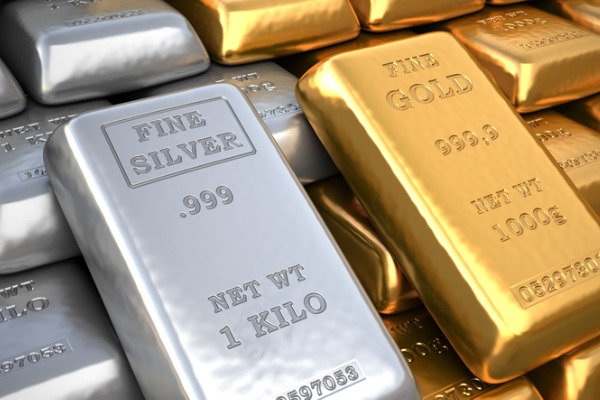Gold versus silver: which is the best safe haven to own?
6th March 2023 10:17
by Kyle Caldwell from interactive investor
Both precious metals have disappointed over the past year. Kyle Caldwell explains why, and considers whether investors should go for gold or silver.

During times of uncertainty investors flock to safe-haven assets, which is exactly happened around this time last year when Russia invaded Ukraine.
Two precious metals that saw their prices initially rise when the war began were gold and silver. Both are among a small number of assets whose value tends to be uncorrelated with other assets. Therefore, when stock markets are going through a rocky patch, both tend to perform well.
- Invest with ii: Free Regular Investing | Interactive investor Offers | ii Super 60 Investments
Gold gets more headlines as a portfolio diversifier, but for good reason. Both metals are volatile, but silver is a much bumpier ride than gold due to its wider industrial use. This means it has greater cyclical characteristics compared to gold.
However, investors with exposure to either metal will have been disappointed in how performance panned out a year on from the invasion. Both metals are in the red, with gold down around 2% and silver losing nearly 14%, as at the start of February.
The main reason why both did not conform to their usual function as ‘insurance policies’ during turbulent times was down to rising interest rates.
As rates go up, the return investors can get from safe government bonds – such as those issued by the US or UK government – also increases, while gold and silver pay no interest.
This means the safe-haven status for gold and silver looks relatively less attractive when income-paying alternatives are considered. The scale of the fixed income sell-off over the past year – because bond prices fell, and yields rose – has been extreme.
- What you need to know about investing in commodities
- 10 of the best mining shares for dividend investors
Another downside, which has been a major headwind over the past year, is the strong US dollar. The value of the greenback typically has an inverse relationship with the gold and silver price. So, when the dollar rises, gold and silver becomes more expensive for international investors to buy due to both being dollar-denominated commodities.
Alison Savas, investment director at Antipodes Partners, points out: “The dollar has been strong because the Federal Reserve has been running much more hawkish policy compared to other central banks. And given gold is priced in dollars, a strong dollar relative to other currencies increased the cost of gold.”
James Penny, chief investment officer at TAM Asset Management, adds: “As Russia invaded Ukraine almost a year ago, we predictably saw a strong reaction from investors who flocked to gold and silver as a safe haven in times of geopolitical uncertainty.
“Largely speaking this was the peak for gold in 2022 as the forces of a rising real yield and ‘King Dollar’ prompted investors to pull profits away from the precious metals market. Silver, with its often greater price volatility to gold, evidenced this trend with an even greater upwards move.”
As well as not having a yield, other weakness for gold and silver is that they do not generate cash flow or profit. Instead, its price simply reflects what the next person is prepared to pay for it, so it tends to be volatile.
- Watch our latest fund manager interviews by subscribing for free to the ii YouTube channel
- Why gold is falling even as Russia threatens nuclear war
In terms of strengths, barring the past year, precious metals have performed well during other periods of stock market turbulence. As a small part of a diversified portfolio, precious metals can help cushion the impact of stock market falls.
In addition, gold has historically provided a hedge against inflation. This is because governments and central banks cannot simply print more gold, as they can currencies. As a result, its value is preserved.
While the macroeconomic backdrop influences the performance of precious metals, a key long-term driver are supply and demand fundamentals.
Outlook for gold and silver
A reversal of the headwinds of the past year would likely send both gold and silver prices higher.
If inflation is contained, lower bond yields and a weaker dollar could both play out.
Penny says: “Looking forward, there remains a short-term driver to precious metals with the prospect of lower inflation driving a weaker dollar and thus boosting prices for gold and silver in a larger magnitude.
“Furthermore, with bonds having such a torrid year in 2022 there remains scope for real yields to compress into 2023 as investors go on the hunt for value.
“With the potential of a US recession still on the cards in the back end of the year, the scope for US treasuries to pick up their historic mandate of a defensive investment could come back to the fore. This could further lower yields, to the benefit of the precious metals market.”
- How many funds should I own in my stocks and shares ISA?
- ISA tips: around the world in eight funds and trusts
- Fund ideas for different ages and stages
Hakan Kaya, senior portfolio manager at Neuberger Berman, adds that the outlook going forward for previous metals is brighter if the US central bank – the Federal Reserve – sticks to a “balanced approach to inflation and growth, as opposed to an aggressive approach”.
Kaya adds:“Several factors, such as a potential interest rate pivot by the Fed and a resulting weakening of the dollar, increased buying from China after its reopening from Covid-19, and a trend towards deglobalization, including a potential petroyuan for oil purchases, could create a favourable environment for gold investment demand.
“However, if the Federal Reserve continues to raise rates and prioritises inflation-fighting over growth, it could put pressure on gold prices. We see this as a lower likelihood event given the front-loaded Federal Reserve action we have seen so far.”

Which metal to own
Kaya advocates a broad-based allocation across different precious metals to reduce risk.
He says: “Precious metals, particularly gold, have a long history as an effective hedge against economic uncertainty. Combining gold with other precious metals in a portfolio can help to balance returns, as gold performs well during periods of economic stress, while silver and platinum group metals (PGMs) have industrial applications that benefit from increased demand during times of economic growth.”
He adds that silver and PGMs play a crucial role in sustainable initiatives, with silver being used in solar panels and PGMs used in emissions-controlling catalytic converters.
How to own gold, silver or both
Two of the main routes are via a specialist fund or an exchange-traded fund (ETF) or exchange-traded commodity (ETC).
Both an ETF and an ETC offer a low-cost way to invest directly in the metal without having to pay for storage or security.
Equity-based commodity ETFs invest in shares of commodity companies, whereas ETCs are instruments that track the price of the commodity, or a basket of commodities.
Penny points out that direct access to precious metals can be attained via iShares, WisdomTree and the Royal Mint’s ETC ranges, to name a few. For gold those options are: iShares Physical Gold ETC (LSE:SGLN), WisdomTree Physical Gold GBP (LSE:PHGP), and Royal Mail Responsibly Sourced Physical Gold ETC.
For silver, passive options include Invesco Physical Silver ETC, and WisdomTree Physical Silver ETC.
There are also leveraged gold and silver ETFs, but these products are highly risky and can easily incur huge losses for investors if the market goes the other way.
On active management, Penny says the likes of BlackRock and Jupiter are also good ways to invest in the two precious metals. Two options are BlackRock World Mining Trust (LSE:BRWM), and Jupiter Gold & Silver.
For investors looking for broader commodity exposure, one of interactive investor’s Super 60 investment ideas is WisdomTree Enhanced Commodity ETF.
Commodities can play a useful long-term role for private investors as a portfolio diversifier, inflation hedge, and as a punt on specific industries or regions. However, due to their volatility it is important to limit exposure.
These articles are provided for information purposes only. Occasionally, an opinion about whether to buy or sell a specific investment may be provided by third parties. The content is not intended to be a personal recommendation to buy or sell any financial instrument or product, or to adopt any investment strategy as it is not provided based on an assessment of your investing knowledge and experience, your financial situation or your investment objectives. The value of your investments, and the income derived from them, may go down as well as up. You may not get back all the money that you invest. The investments referred to in this article may not be suitable for all investors, and if in doubt, an investor should seek advice from a qualified investment adviser.
Full performance can be found on the company or index summary page on the interactive investor website. Simply click on the company's or index name highlighted in the article.